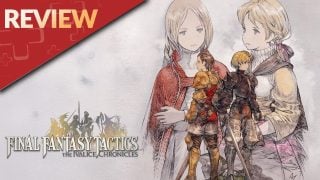Xenoblade Chronicles seems to have become one of Nintendo’s biggest franchises in recent years, with the upcoming X being Nintendo’s biggest holiday 2015 release. It’s a far cry from the days of Operation Rainfall, when fans tried to convince Nintendo of America to release the already translated original game in their territory.
Despite this newfound popularity, many might not know that the Xenoblade games are part of an extended series stretching even further back, although Nintendo wouldn’t let you know it. While their stories are disconnected, much like the way Final Fantasy main games are unrelated to one another, the “Xeno” series has been a part of the JRPG landscape ever since the original PlayStation.
So join us as we look through the history of director and writer Tetsuya Takahashi and his co-workers, and compare the recurring themes of their enduring role playing games. Just as a warning, there will be minor spoilers for all of the games, but nothing too explicit:

Xenogears (1998)
The only game developed before Monolith Soft was formed, Xenogears began development at Squaresoft under a different name: Final Fantasy VII. Yes, that one. Pretty early in development the game was deemed “too dark and complicated for a fantasy,” but luckily Takahashi was allowed to continue crafting the title with its new name.
This dark and complicated story stars Fei, a young man who just so happens to have retrograde amnesia, but what starts as a JRPG-trope laden story quickly devolves as Fei’s quaint country life is ripped apart violently at his own hands. Pretty soon he’s exiled and heads out on a quest for answers and redemption.
It’s at this point that we need to talk about one of the core themes prominent in Xenogears but prominent throughout the Xeno series: Psychology. Specifically the principles put forth by Friedrich Nietzsche, Sigmund Freud and Carl Jung. While we won’t go into too much detail on those in this article (it’s hard to do them justice and I’m really not qualified), it’s fascinating to see just how deep the Tetsuya Takahashi’s games can be.
Just as an example, a major antagonist in the game is “Id,” and just so happens to be the dissociative personality of another major character, spawned by their childhood psychological trauma. Taking cues from Sigmund Freud’s observations, the Id is the “instinct” part of the brain, and thus can be more destructive, in comparison to the super-ego; a more peaceful and stable personality type.
The gameplay in Xenogears combines the active time battles of Final Fantasy with a system not unlike that of a fighting game, with special moves being unleashed through specific button sequences. At various points in the story you also get the ability to traverse the world and various dungeons piloting “Gears”; massive mechs not unlike Xenoblade Chronicle X’s Skells.

Xenosaga (2002-2006)
Monolith Soft’s first game as an independent developer, Xenosaga, was always imagined as a genuine saga; a long-running, complicated series of events. The original plan of six titles had to be cut down to just three episodes, each released for the PlayStation 2. Set in a distant future after archaeologists discovered an ancient alien artifact on Earth, space-faring humans are faced with growing conflicts between interstellar corporations hoping to obtain or emulate the artifact’s seemingly limitless power.
This concept of a post-Earth future is also going to be a significant part of the Xenoblade Chronicles X plot. In contrast, however, the events of Xenosaga are set so far in the future that even the name of Earth is forgotten, whereas the upcoming Wii U game seems to take place immediately after its evacuation, as society begins rebuilding and recolonizing.
The psychological themes of Xenogears were also carried over, and became an even bigger focus. Even the subtitle for each episode refers to the works of Nietzche; for example, Episode 1’s “Der Wille Zur Macht” translates to “the will to power,” a collection of writings that go into his interpretation of humanity’s driving force of nature: to achieve and gain the highest position possible in life.
Xenosaga was also the debut of one of Tetsuya Takahashi’s most famous characters: KOS-MOS. A female android built to fight the enigmatic alien Gnosis, KOS-MOS is a natural evolution of one of the other key themes in Xenogears; the relationship between man and machine. KOS-MOS has since become something of a minor mascot for publisher Namco, making cameo appearances in the likes of Soul Calibur, the Tales of Series and Project X Zone.
KOS-MOS also allowed Takahashi to delve even deeper into the subject of philosophy, with the games and her character in particular featuring more than a few allusions to Christian mythology. Even the password to activate her, “Ye shall be as gods,” is a phrase lifted directly from the Bible (Genesis 3:5 to be exact).
The gameplay of the Xenosaga games changes things up by abandoning the active time battles and opting instead to go with a turn-based system, much like the one found in Final Fantasy X. Players can still manipulate the turn-order, however, through the use of a “Boost” gauge, but be warned: enemies can counter-act these attempts to jump ahead in line. Mech-based combat also returns with the A.G.W.S. system, where a character can sacrifice turns and the ability to use items in exchange for more powerful attacks and special moves.

Xenoblade Chronicles (2010)
The theme of Gods was taken to an extreme after Nintendo and Monolith Soft teamed up for the first Xenoblade Chronicles, with the entire adventure taking place across the static bodies of the world’s deities: Bionis and Mechonis.
On the surface, Xenoblade Chronicles might seem like a more accessible game compared to its predecessors, with its more action-oriented fluid combat and seemingly simpler story. The deeper you get into the game, however, you can see Tetsuya Takahashi continuing to build on the themes he laid out in his previous titles.
Even the most iconic image of the game, the Monado sword, takes its name from the “Monad”, a term found in many philosophical texts to define the theoretical underlying element of reality (be it a God or an energy). Players who have seen the game through to the end will understand the significance of this naming.
As previously mentioned, Xenoblade Chronicles has major changes in terms of gameplay compared to Xenogears and Xenosaga, taking more cues from massively multiplayer online RPGs like World of Warcraft. Attacks work on a cool-down, while things such as elemental weaknesses and positioning are significant when it comes to taking down stronger monsters. Unfortunately, Xenoblade Chronicles is the only game in the series without pilot-able mechs.
One of the major gameplay additions is Shulk’s premonitions, granted by the Monado. When the party faces a dire situation where some of them may die, the game gives the player quick glance into the future and gives you the opportunity to change it. This feature is also significant to the narrative and supports the game’s general theme of fighting fate.
Hopefully that wasn’t too deep a dive into the common themes and history of the Xeno series! If you’re interested in learning more about the psychological and philosophical inspirations be sure to read up on the original texts.
The question now is: Just how deep will Xenoblade Chronicles X go? As already noted, the game seems to share more than a few similarities with its predecessors, so it really wouldn’t be a surprise to see it take just as many interesting twists and turns throughout the story.
Leave a Comment

